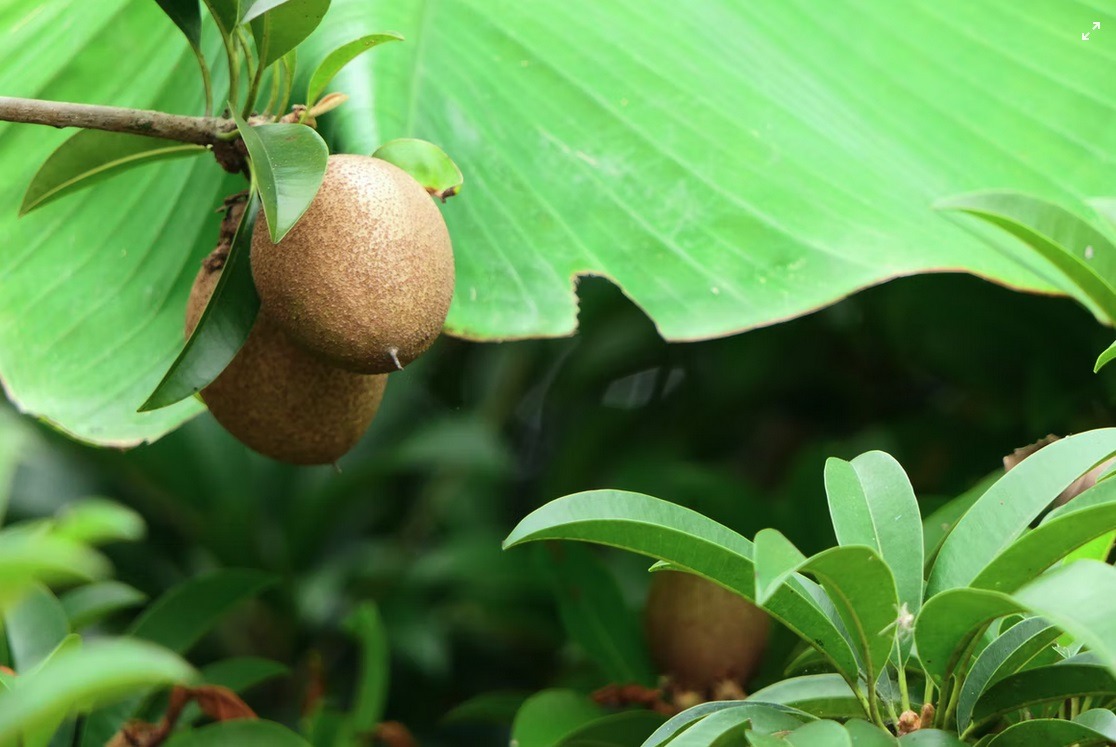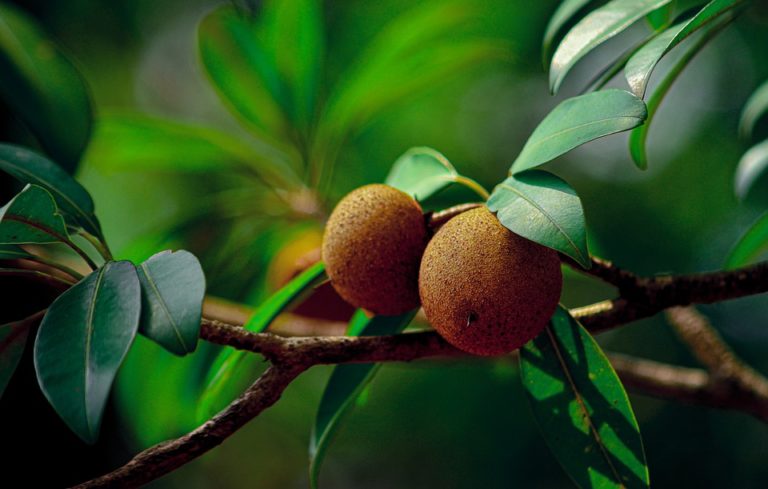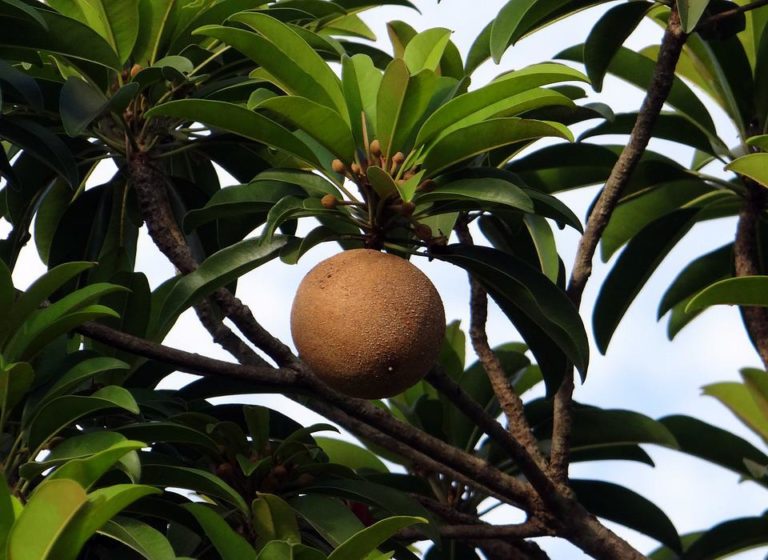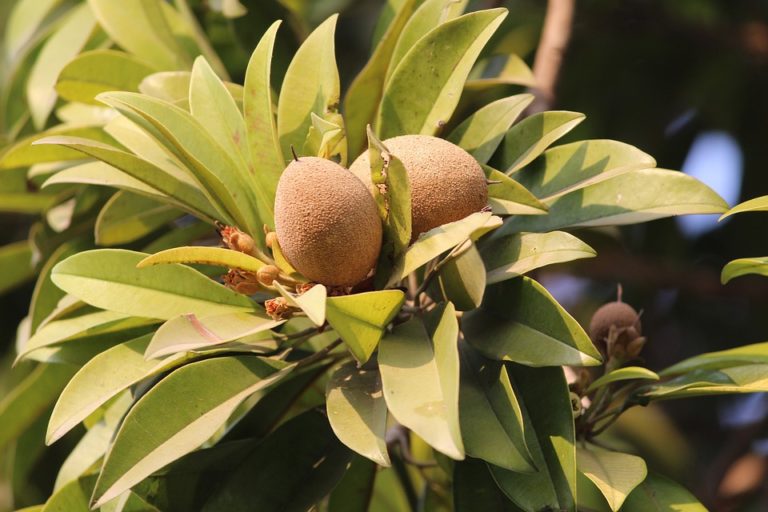Chances you’ve already seen popular trees from Maple, Oak, Fir, Pine, Elm, to Willow trees, but have you ever heard about the Sapodilla tree? Native to South America, this exotic fruit tree has spread through time in Asia and now serves substantial economic importance in the tropics and offers many health benefits to its consumers. Continue reading below as we’ll learn more about and discover fascinating and interesting facts about the Sapodilla tree.
Botany
Sapodilla tree is a slow-growing, long-living evergreen tree, which normally grows 20 to 60 feet in cultivation. In the wilderness, it can reach heights of up to 100 feet. Its trunk has hard bark that produces a white, gummy latex called chicle. Its dark green oval-shaped leaves are glossy, grouped in spirals at the end of the forked twigs. Meanwhile, the shaped-belled flowers are small and come in a cream color.
Sapodilla tree yields fruit, a large berry that is 2-3 inches in diameter. It’s shaped like an egg with grainy pale yellow to earthy brown flesh inside, while its skin is rough, brown when ripe. The fruit is very sweet and juicy, often compared to that of a pear, but also has notes of caramel, dates, chocolate, persimmon, honey, and even coffee.
A popular fruit in the tropics, it’s also a favorite in the wild, with tapirs, monkeys, peccaries, and kinkajous fond of eating this exotic fruit. Bats pollinate sapodilla trees while drinking the nectar from its flowers, and also help propagate the seeds as they carry and eat the fruit and eventually drop the seeds.
Habitat
Sapodilla (Manilkara sapota) is native to Southern Mexico, including the Yucatan peninsula, Northern Belize, and Northwestern Guatemala, thriving in the wild since ancient times. It’s also found in Old World tropics and the West Indies, where the tree was introduced and cultivated hundreds of years ago. Typically, they grow in tropical and subtropical regions situated at 9,000 feet at the equator and at sea level in mid-latitude regions.
From their native origins, it is believed that they have proliferated in Central America in the early ages through natural propagation, animal feces, and human cultivation. They soon reached the Florida Keys, the Caribbean, and South American regions. In the 17th century, it was brought to the Philippines and has spread across Southeast Asian countries over the next two centuries.
Today, the Philippines and India lead the world in terms of sapodilla production, but they’re also commercially cultivated in Mexico and Guatemala. Other countries that grow them include Vietnam, Thailand, Indonesia, Pakistan, Malaysia, Cambodia, Bangladesh, Australia, and South Africa.
Importance
Sapodilla trees provide a number of benefits to humans. During the ancient time, the Aztecs and Mayan civilizations discovered that the trees’ white, gummy sap can be used in producing building blocks through boiling and molding. They also took part and sliced them into small pieces for chewing to clean teeth, freshen their breath, fight hunger, and quest thirst. This is technically the first chewing gum!
As such, chicle was eventually used in making chewing gums, though it was later replaced as producing chicle requires extensive labor. Chicle was hand-harvested by workers, who needed to climb trees up to 50 feet and make cuts down in a zigzag pattern to release the white, gummy sap and then be collected and stored in containers.
Of course, the sapodilla is also prized for its fruit, which is also known as chikoo, sapota, naseberry, zapote, sepadilla, and zapotillo in other countries worldwide. Mostly eaten raw, the fruit can also be made into juice, sherbet, ice cream, custard, jam, and other desserts.
Sapodilla fruits also offer many health benefits. It’s an excellent source of dietary fiber, which aids and stimulates the digestive system and promotes proper bowel movement. It’s also rich in antioxidants like ascorbic acid, polyphenols, and flavonoids that give the fruit anti-aging and anti-cancer properties. Packed with other vitamins and minerals, the fruit’s other health perks include anti-inflammatory and anti-bacterial properties, blood pressure reduction, better bone health, and boosting immunity.
Meanwhile, the sapodilla trees’ wood is also strong and durable. In ancient times, the Mayans used them for beams and lintels in their temples. Today, timber is utilized for furniture, floorings, tool handles, and crossties for railways.
More Fascinating and Interest Facts About The Sapodilla Tree
- Sapodilla tree hails from the Sapotaceae family, where other 800 tropical evergreen shrubs and trees that yield edible fruits belong.
- A sapodilla fruit can weigh around 100 to 170 grams. The average weight is 150 grams.
- Sapodilla has one to six hard, black oval seeds that measure 2 centimeters long. The seeds must be removed before consuming the fruit as they have hooks at the end that may cause them to get stuck in the throat.
- Sapodilla fruit has a very short shelf life, only around two to three days. That’s why it’s hard to find in countries far from where they’re grown.
- It was during the Spanish colonization that the Sapodilla tree was introduced to the Philippines.
- A sapodilla tree yields fruit twice each year, but flowering may persist throughout the year.
- An adult sapodilla tree can produce around 3,000 fruits per annum.
- Sapodilla trees only thrive in warm, tropical environments. It will die quickly when exposed to below-freezing temperatures.
- Starting from germination, a sapodilla tree usually needs between five to eight years before it can bear fruit.
- Sapodilla trees’ young fruits, leaves, and flowers are used in traditional medicine for treating diarrhea and soothing pulmonary ailments.
- Raw sapodilla fruit tastes bitter as it has high amounts of tannins and latex.
- Only the newer, younger leaves of the sapodilla tree are edible and are only usually consumed by boiling them and making tea. Mature leaves contain alkaloids that are toxic to the human body.
- Eating an unripe sapodilla fruit may also cause breathing problems, mouth ulcers, and throat irritation.
- Other names for the sapodilla include “nispero” in Costa Rica, Guyana, Cuba, El Salvador, Dominican Republic, and Puerto Rico, “mispel” in the Dutch Caribbean and the Virgin Islands, and “dilly” in the Bahamas.
- Sapodilla tree crowns usually appear like pyramids.




